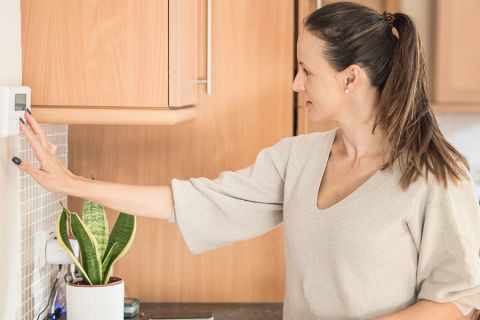Many homeowners are caught off guard by their rising electricity bills. Despite their efforts to conserve energy, various unnoticed factors may be driving up costs. Identifying these “energy hogs” in your home is the first step towards achieving better energy efficiency and savings. Are you curious about what uses the most electricity in your home? It might be more than just leaving the lights on or forgetting to turn off appliances.
Knowing what uses the most electricity allows you to take informed steps to manage your energy consumption better. From heating and cooling systems to everyday appliances, it’s essential to understand which household items are the main culprits. When you know where your electricity is being used, you can target specific areas for improvement and potentially save a significant amount on your electricity bills.
Overview of Major Energy Hogs
“energy hogs” refers to household items or systems that consume significant electricity. To identify these, consider energy experts’ data highlighting which appliances and systems typically draw the most power. According to energy-saving reports, heating, cooling, major home appliances, and lighting can significantly impact your overall energy consumption. Recognizing these energy hogs means you can take strategic steps to reduce their impact on your electricity usage.
Heating and Cooling Systems
Heating and cooling systems frequently use up the most electricity in a household. HVAC systems, especially older models, can be highly inefficient. According to recent studies, heating and cooling account for nearly half of the energy usage in an average household. Ensuring these systems are well-maintained can lead to significant savings. For instance, a clogged air filter can put undue pressure on your HVAC system, causing it to work harder and consume more electricity.
Maintaining Your HVAC System
Regularly changing air filters, scheduling annual checkups, and using programmable thermostats can help you manage energy usage. A programmable thermostat enables you to adjust the temperature for increased energy efficiency while away from home. Additionally, insulating your home can decrease the workload on your HVAC system, making it more energy-efficient. Adding insulation to attics, walls, and basements ensures less heating or cooling energy escapes your home, reducing the need for the HVAC system to run constantly.
Water Heaters
Water heaters are another major energy consumer. They work continuously to keep water hot and ready for use, often contributing to high energy bills. Traditional tank water heaters store and continually heat a large volume of water, which can be inefficient. Upgrading to an energy-efficient water heater or adopting a lower temperature can help reduce this load. For instance, setting your water heater temperature to 120 degrees Fahrenheit can prevent energy loss without reducing comfort.
Energy-Efficient Water Heating Solutions
Choose tankless or solar water heaters that consume less energy. Tankless water heaters do not store water but rather heat it as needed, resulting in noticeable energy efficiency. Solar water heaters utilize sustainable energy from the sun to warm your water, significantly cutting down on your energy usage. Moreover, performing routine maintenance like flushing the tank to eliminate sediment can enhance efficiency by guaranteeing the proper functioning of the heating elements in your water heater.
Lighting
Lighting, though seemingly minor, can add up. Incandescent bulbs, for instance, use more energy compared to LED lights. Switching to energy-efficient lighting solutions can result in noticeable savings over time, as per an article on tips for saving energy, minor adjustments in lighting can have a significant impact. Incandescent bulbs generate excess heat rather than light, resulting in inefficiency and potentially raising your summer cooling costs.
Switch to LED Lighting
LED bulbs consume less energy and last longer than traditional incandescent bulbs. By making this switch, you can reduce your lighting costs by up to 75%. LEDs are also available in various colors and brightness levels, making it easy to meet your household’s lighting needs without compromising energy efficiency. LEDs produce less heat than incandescent bulbs, supporting eco-friendly and environmentally conscious behaviors.
Major Home Appliances
Appliances like refrigerators, washing machines, and dishwashers are essential but can be hefty power users. The key to managing this is understanding their energy consumption levels and looking for energy-efficient options when replacement is necessary. Always check the energy rating labels when purchasing new appliances.
Smart Appliances
Consider investing in smart appliances that offer energy usage data and allow remote control. Smart refrigerators, for example, can detect when they are overly full and need to adjust the temperature. Intelligent washing machines can optimize washing cycles based on load size and fabric type. This way, you can monitor and optimize how and when your appliances are used, providing both convenience and efficiency. These appliances can notify you of potential energy-saving opportunities, contributing to overall household energy management.
Effective Counter-Measures
Knowing where your energy is going is half the battle. Consider these measures to counter the energy hogs in your home:
- Regular maintenance of HVAC systems ensures they are running efficiently.
- Upgrading to energy-efficient water heaters and lighting can drastically reduce your energy usage.
- Using smart appliances that provide energy usage data can help you understand and manage consumption patterns.
- Implementing home insulation techniques reduces the need for heating and cooling by keeping your home at a stable temperature.
- Making small changes, such as turning off lights and disconnecting devices when not in use, can result in substantial savings in the long run.
Final Thoughts
Understanding and tackling the hidden energy hogs in your home can lead to substantial savings and a more sustainable lifestyle. By continually assessing and optimizing your energy usage, you not only cut down on costs but also contribute to a greater environmental good. Awareness and informed actions are your most significant tools in the fight against excessive energy consumption. These steps benefit your wallet and align with broader efforts to conserve resources and protect the environment.





